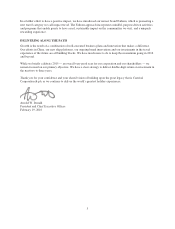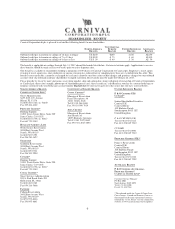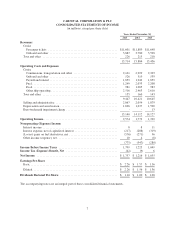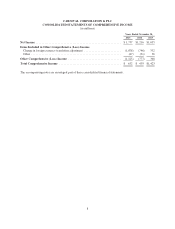Carnival Cruises 2015 Annual Report Download - page 16
Download and view the complete annual report
Please find page 16 of the 2015 Carnival Cruises annual report below. You can navigate through the pages in the report by either clicking on the pages listed below, or by using the keyword search tool below to find specific information within the annual report.
Preparation of Financial Statements
The preparation of our consolidated financial statements in conformity with accounting principles generally
accepted in the United States of America requires management to make estimates and assumptions that affect the
amounts reported and disclosed in our financial statements. Actual results may differ from the estimates used in
preparing our consolidated financial statements. All significant intercompany balances and transactions are
eliminated in consolidation. Certain prior period amounts have been reclassified in the Consolidated Balance
Sheets and the Consolidated Statements of Cash Flows to conform to the current period presentation. The
reclassifications in the Consolidated Statements of Cash Flows had no impact on net cash provided by operating
activities and net cash used in investing and financing activities.
Cash and Cash Equivalents
Cash and cash equivalents include investments with maturities of three months or less at acquisition, which are
stated at cost.
Inventories
Inventories consist substantially of food and beverages, hotel and restaurant products and supplies, fuel and gift
shop merchandise held for resale, which are all carried at the lower of cost or market. Cost is determined using
the weighted-average or first-in, first-out methods.
Property and Equipment
Property and equipment are stated at cost. Depreciation and amortization were computed using the straight-line
method over our estimates of useful lives and residual values, as a percentage of original cost, as follows:
Years
Residual
Values
Ships ................................................... 30 15%
Ship improvements ........................................ Shorter of remaining ship
life or useful life (3-28)
0%
Buildings and improvements ................................ 10-35 0% or 10%
Computer hardware and software ............................ 3-10 0% or 10%
Transportation equipment and other .......................... 3-20 0% or 10%
Leasehold improvements, including port facilities ............... Shorter of lease term or
related asset life (3-30)
-
The cruise industry is very capital intensive, and at January 22, 2016, we operated 99 cruise ships. Therefore, we
have a capital program that we develop for the improvement of our ships and for asset replacements in order to
enhance the effectiveness and efficiency of our operations; comply with, or exceed all relevant legal and
statutory requirements related to health, environment, safety, security and sustainability; and gain strategic
benefits or provide newer improved product innovations to our guests.
Ship improvement costs that we believe add value to our ships, such as those discussed above, are capitalized to
the ships and depreciated over the shorter of their or the ships’ estimated remaining useful life, while costs of
repairs and maintenance, including minor improvement costs and dry-dock expenses, are charged to expense as
incurred and included in other ship operating expenses. Dry-dock costs primarily represent planned major
maintenance activities that are incurred when a ship is taken out-of-service for scheduled maintenance. We
capitalize interest as part of the cost of acquiring ships and other capital projects during their construction period.
The specifically identified or estimated cost and accumulated depreciation of previously capitalized ship
components are written-off upon retirement, which may result in a loss on disposal that is also included in other
14
























